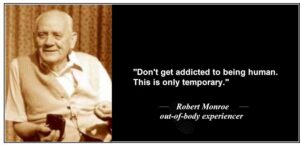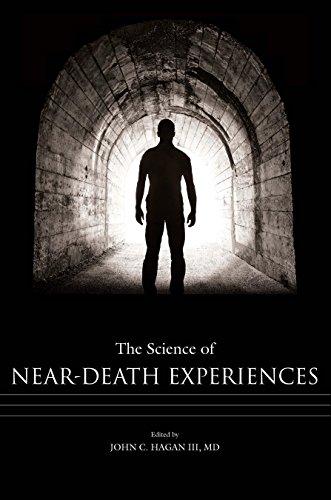This site uses affiliate links to Amazon.com Books for which IANDS can earn an affiliate commission if you click on those links and make purchases through them.
1. About Robert Monroe
Robert Monroe (1915-1995) was a distinguished radio broadcasting executive and pioneer in consciousness studies who founded The Monroe Institute (www.monroeinstitute.org), a worldwide organization dedicated to expanding human potential. His classic Journeys Out of the Body introduced the term “out-of-body experience” (OBE) and involves inducing mental states beyond space, time, and even death.
Monroe became famous for discovering how specific sounds have the ability to produce out-of-body states and positive enhancements to consciousness including sleep, relaxation and expanded awareness. Monroe developed the Hemi-Sync Method, an audio technology where specific sounds are able to coax the brain into various beneficial states. In 1958, while Monroe was experimenting with ways to enhance learning while in a sleep state, he experienced sleep paralysis and bodily vibrations followed by seeing a bright light. Then after several weeks of experimenting he induced his first out-of-body experience. Monroe is also the author of two more classics: Far Journeys and Ultimate Journey.
2. Robert Monroe’s Method by Dr. Susan Blackmore
The following is an excerpt from Dr. Susan Blackmore (www.susanblackmore.uk) in her book, Beyond the Body: An Investigation of Out-of-the-Body Experiences (1992) where she describes Robert Monroe’s method of inducing an out-of-body experience. Dr. Blackmore is one of the few NDE researchers who has actually experienced an OBE. Although she is a skeptic of claims suggesting NDEs are evidence supporting the Afterlife Hypothesis, she is a recognized authority in both NDEs and OBEs. In the Nov-Dec 1984 of the Parapsychology Review, Marilyn Schlitz of the Institute of Noetic Sciences, had the following to say about Dr. Blackmore’s book:
“I applaud the phenomenological approach which underlies Blackmore’s approach to the OBE. Perhaps the most important contribution put forth in Blackmore’s book is the psychological model found in Chapter 22 … an important source for anyone with an interest in psi research … an enjoyable experience and is highly recommended reading.”
In the Spring 1984 edition of Anabiosis (now the Journal of Near-Death Studies), Emily W. Cook of the University of Virginia Division of Perceptual Studies, described Dr. Blackmore’s book as:
“A survey of OBE research that is both readable and scholarly.”
Other books by Blackmore include: The Meme Machine (2000), Consciousness: An Introduction (2003), and Conversations on Consciousness: What the Best Minds Think about the Brain, Free Will, and What It Means to Be Human (2007), all of which I highly recommend.
In his book, Journeys Out of the Body, Robert Monroe describes a complicated-sounding technique for inducing OBEs. In part, it is similar to other imagination methods, but it starts with induction of the “vibrational state”. Many spontaneous OBEs start with a feeling of shaking or vibrating, and Monroe deliberately induces this state first. He suggests you do the following. First lie down in a darkened room in any comfortable position, but with your head pointing to magnetic north. Loosen clothing and remove any jewelry or metal objects, but be sure to stay warm. Ensure that you will not be disturbed and are not under any limitation of time. Begin by relaxing and then repeat to yourself five times:
“I will consciously perceive and remember all that I encounter during this relaxation procedure. I will recall in detail when I am completely awake only those matters which will be beneficial to my physical and mental being.”
Then begin breathing through your half-open mouth.
The next step involves entering the state bordering sleep (the hypnagogic state). Monroe does not recommend any particular method of achieving this state. One method you might try is to hold your forearm up, while keeping your upper arm on the bed, or ground. As you start to fall asleep, your arm will fall, and you will awaken again. With practice you can learn to control the hypnagogic state without using your arm. Another method is to concentrate on an object. When other images start to enter your thoughts, you have entered the hypnagogic state. Passively watch these images. This will also help you maintain this state of near-sleep. Monroe calls this Condition A.
After first achieving this state, Monroe recommends to deepen it. Begin to clear your mind and observe your field of vision through your closed eyes. Do nothing more for a while. Simply look through your closed eyelids at the blackness in front of you. After a while, you may notice light patterns. These are simply neural discharges and they have no specific effect. Ignore them. When they cease, one has entered what Monroe calls Condition B. From here, one must enter an even deeper state of relaxation which Monroe calls Condition C — a state of such relaxation that you lose all awareness of the body and sensory stimulation. You are almost in a void in which your only source of stimulation will be your own thoughts.
The ideal state for leaving your body is Condition D. This is Condition C when it is voluntarily induced from a rested and refreshed condition and is not the effect of normal fatigue. To achieve Condition D, Monroe suggests that you practice entering it in the morning or after a short nap. With eyes closed, look into the blackness at a spot about a foot from your forehead, concentrating your consciousness on that point. Move it gradually to three feet away, then six, and then turn it 90 degrees upward, reaching above your head. Monroe orders you to reach for the vibrations at that spot and then mentally pull them into your head. He explains how to recognize them when they occur. “It is as if a surging, hissing, rhythmically pulsating wave of fiery sparks comes roaring into your head. From there it seems to sweep throughout your body, making it rigid and immobile.” This method is easier than it sounds.
Once you have achieved the vibrational state, you have to learn to control it, to smooth out the vibrations by “pulsing” them. At this point, Monroe warns it is impossible to turn back. He suggests reaching out an arm to grasp some object which you know is out of normal reach. Feel the object and then let your hand pass through it, before bringing it back, stopping the vibrations and checking the details and location of the object. This exercise will prepare you for full separation.
To leave the body, Monroe advocates the “lift-out” method. To employ this method, think of getting lighter and of how nice it would be to float upwards. An alternative is the “rotation” technique in which you turn over in bed, twisting first the top of the body, head and shoulders until you turn right over and float upwards. Later you can explore further. With sufficient practice Monroe claims that a wide variety of experiences are yours for the taking.










